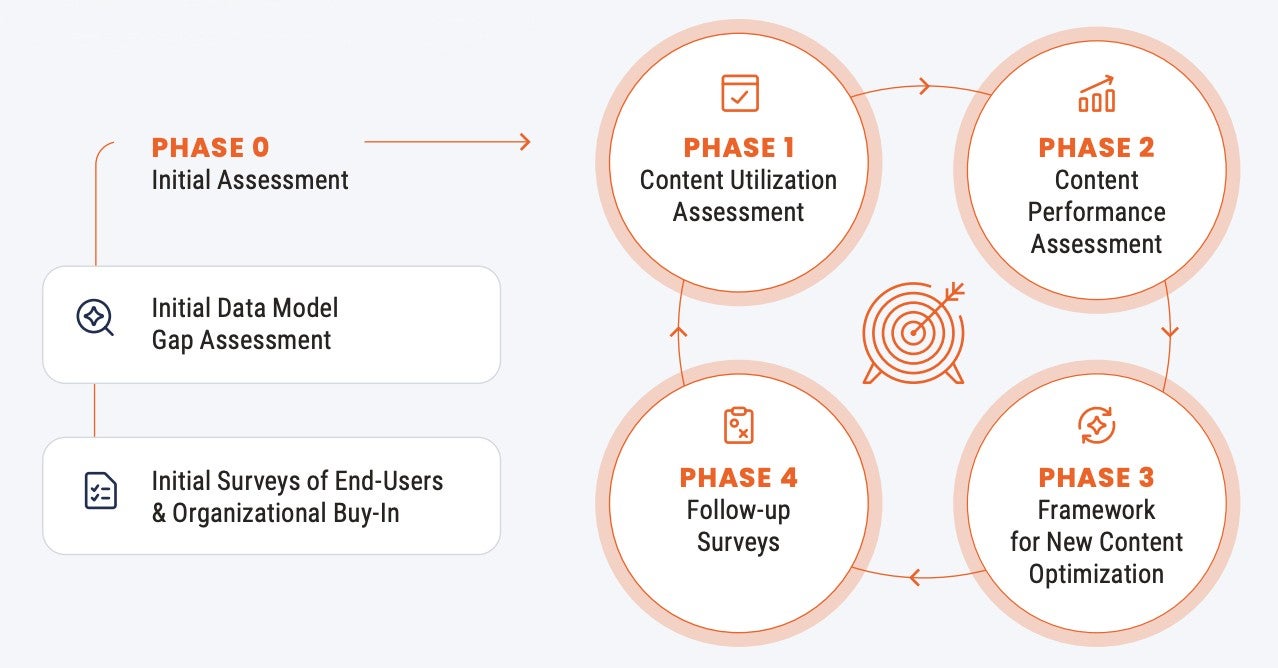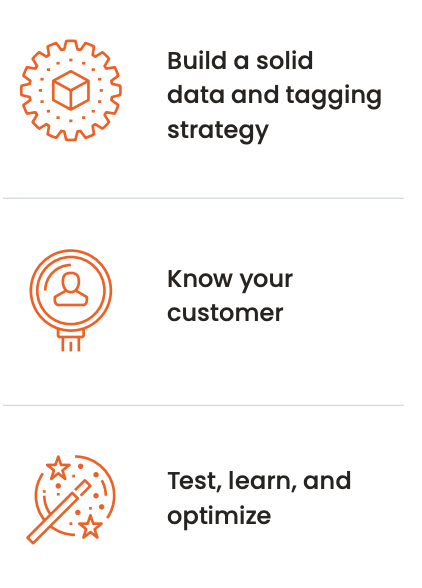Article
4 Phases to More Effective Biopharma Content
The industry takes two primary approaches to commercial content strategy, and both are contributing to an unprecedented volume of material (Figure 1):
- Traditional models push out a great deal of content,hoping some land with the right HCPs to spur action
- Methods like modular content use personalization and channel-specific messaging for individuals
Yet, 77% of the content commercial teams create is rarely or never used in the field. What’s disappointing is, “[s]omewhere in all of that underutilized content is information that will move the needle for HCPs and patients,” says John Postley, Boehringer Ingelheim’s Senior Associate Director of Content Strategy and Impact. Commercial teams often compensate with high content volumes when they don’t fully understand customer needs.
FIGURE 1: Biopharmas churn out content at unprecedented rates

What effective content looks like
Sharing content in a two-way conversation, especially in digital and inbound channels like compliant chat, is crucial to serving customers well. According to one HCP: “We need three things from the industry to get the right patient outcome: trustworthy, high-quality product information, scientific education for us as physicians, and research insights.”
For specialty therapies in particular, HCPs need specific and timely guidance. As they initiate patient treatment, they navigate site certification, reimbursement issues, and more. In addition to informing HCPs, effective content can help your field team extend the duration of meetings.
Postley sees industry-wide progress toward creating content that meets individual HCP needs, which helps decrease volumes and maximize effectiveness of the content. However, some areas are ripe for improvement, including workflows for updating legacy content and content tagging hygiene.
His team recently conducted an effectiveness study of compliant personal-promotional content1 to:
- Gather deep knowledge of customers
- Strengthen their content data and tagging strategy
- Optimize content through regular reporting
Why it’s hard to gauge content effectiveness
The goal seems simple: Create fewer assets with high field buy-in to create impactful discussions with HCPs. The approach redirects resources toward delivering more connected, personalized customer experiences.
However, even if your team knows that some content misses the mark for HCPs, you might not know how to course- correct. That means you have blindspots when creating new content and determining what legacy content is worth updating, Postley says.
Some common issues prevent commercial teams from understanding compliant content2 consumption and effectiveness (Figure 2):
- Most don’t regularly measure internal content use, so they lack a ‘track record’ of performance in or across franchises
- Few compare content performance to industry benchmarks despite their ease of use
- Many don’t use metadata or tag content, making it hard for search engines to index it and customers to find it
- Metrics aren’t coming in fast enough for teams to make adjustments and improve campaign outcomes
FIGURE 2: Obstacles to assessing and measuring content

Fix foundational data first
Postley, a content strategist, first checks whether the content structure of an asset is sound. He believes in a similar approach to looking at a compliantdata structure.3 “If you don’t have good data going in, you won’t have good data coming out.” He recommends:
- Having the proper metadata that is reflective of your commercial strategy
- Ensuring you have the correct tags identifying the right audiences
- Aligning messages with the proper channels to reach HCPs at the moments that matter
He says it’s hard work to own these pieces of the strategy, right down to populating the correct fields in your database. However, the payoff is immense. “One of our breakthroughs was being able to tag 96% of the content with the key message type — applying a simple, brand-agnostic tag. That enabled impactful insights for us.”
Regarding getting insights quickly, Postley says, “Given that it’s pharma content, you’re not likely to have real-time data without real-time deployment, but it doesn’t mean we can’t try. Quarterly reporting is too late; monthly is pretty good. But we want to be able to gain velocity. And that will depend on how organized and agile your teams are regarding the data.”
Consider an effectiveness study if it’s time to assess customer engagement with your content (Figure 3).
FIGURE 3: Content effectiveness study phases

“One of our breakthroughs was being able to tag 96% of the content with the key message type — applying a simple, brand- agnostic tag. That enabled impactful insights for us.”
PHASES 0-1 Readiness assessment and content utilization survey
Stakeholder buy-in was crucial for Boehringer Ingelheim’s content effectiveness study. “All of the critical pillars that own pieces of the content workflow and lifecycle must be aligned, and that involves a lot of communication and listening,” he says.
Gauging field sentiment about the content is significant: “Marketing has personas, segments, and strategy to inform our views, but we don’t have the direct relationship with customers like reps do.” In addition to the field force, his team collaborated closely with MLR, brand, analytics, and omnichannel teams — as well as agency partners — to survey the content inventory for gaps and areas of strength.
“All of the critical pillars that own pieces of the content workflow and lifecycle must be aligned, and that involves a lot of communication and listening.”
PHASE 2 Content performance assessment
While HCPs are limiting their access to biopharma reps, as Veeva Pulse Field Trends data shows, engagement models prioritizing relevance and timeliness over volume are opening doors. Knowing what content is relevant and personalizing it requires applying knowledge gained from internal data and industry benchmarks. As a result, the focus of Phase 2 was continuous testing and learning.
“A lot of content must exist for compliance and other reasons, but for the remainder, we want to understand what the field is using, how they use it, and why we’re not at 90 or 100% usage,” Postley says.
PHASE 3 Content optimization
Next, Boehringer Ingelheim connected content use and performance. This study phase yields data on the next best actions for personal-promotional content and its effectiveness for customers.
Postley says one of the great things about the content effectiveness study is validating their hypotheses and gaining essential insights across pillars and disciplines. For example, “We’re focusing on modular content, and there’s change management involved. Exposing everyone to the study results and getting buy-in to the optimization approach allows us to lay the groundwork for that structured content,” Postley says.
His key takeaways (Figure 4): “If you want to measure content effectiveness, start with the right strategy. Understand your customers, understand how you’re deploying your content, position it in a structured environment, and tag it.”
PHASE 4 Follow-up surveys
The team shared the results with brand and indication content owners and has begun to see behavior changes in content creation. Separately, he says, “A critical partner was our analytics team.”
The team will continue testing, learning, and optimizing in this area.
FIGURE 4: Key takeaways for measuring content effectiveness

